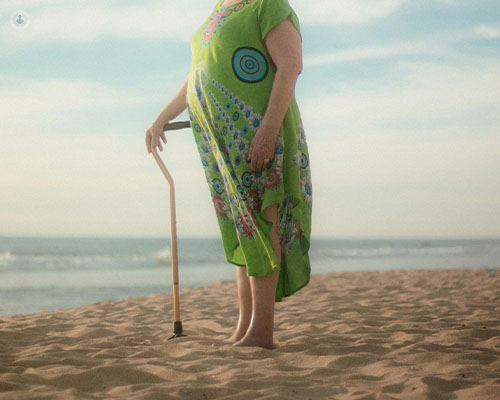Hip replacement: what to expect before and after surgery
Written in association with:Hip replacement surgery is a corrective procedure to restore flexibility, functionality, and movement to the hips, located at the joint where the leg meets the pelvis. The thigh bone called the femur, fits into a niche of the pelvis called the acetabulum, in a ball-and-socket joint. It is synovial, meaning that there is cartilage and a lubricative fluid that sits between the two bones and allows ease of movement without pain. Hip replacements are necessary when this cartilage deteriorates, or if the patient has been in a bad accident that has damaged their hips or suffering from extreme arthritis and cannot walk even with a stick or frame. We sat down with a leading orthopaedic surgeon to discuss the expectations of hip surgery outside of the operating room.

What happens during a hip replacement?
The procedure involves the femoral head of the femur (the ball) being replaced with a synthetic head made of metal or ceramic that’s fitted to a metal stem fixed inside the femur, and is repositioned back into the acetabulum of the pelvis (the socket) that has been fitted with a metal socket lined with ceramic or plastic. Hip replacements are supposed to last for at least 20 years in which patients can enjoy mobility and no stiffness.
The whole procedure takes only about two hours under a regional and a general anaesthetic. Most patients are up and about and can go home on the day of the surgery, but on occasion stay overnight. They are not encouraged to drive for 4 to 6 weeks.
What should patients do before a hip replacement?
Stopping smoking in general is encouraged, but especially one to two months before surgery to lower the risk of surgical complications. To prepare before the surgery, patients should be engaging in light physical activity, namely “prehabilitation” (prehab) to keep the body strong, however much is tolerable or possible with any pain or damage. This will consist of stretches and strength training. The patient should consult with their doctor before surgery so that they know the parameters of what they cannot and cannot do in the time after the surgery.
Physical therapy will be needed after the surgery so that the new hip can be utilised to its fullest potential, so it is a good idea to get it set up beforehand so that the therapy can begin as soon as possible. Patients should prepare their homes to accommodate them as they heal, meaning that trip-hazards are removed and important things are within easy reach.
Before the procedure, the patient will participate in a preoperative study to ensure they’re fit for surgery. This consists of blood tests, chest X-rays, and an echocardiogram. For any other essential information, the doctor will communicate with the patient before the surgery.
What happens right after a hip replacement?
Pain and swelling of the joint are expected after the surgery, and will persist for some time, but the pain should not be unbearable and be more of an ache. Taking breaks and icing the hip can help alleviate the discomfort. Patients may be given painkillers in order to manage pain.
Patients should be able to walk within a day of the surgery, but a stick or walking frame may be needed at first as they adjust to the new hip. When sleeping or resting, patients should keep the leg of the hip elevated when possible, and wear shoes with good sole support, if possible.
The incision site will have either sutures, clips or glue, so advice regarding contact with water will vary depending on the sutures and dressings, but generally, taking baths and swimming should be avoided until fully healed. Showers should be fine, as long as the patient is careful not to get the incision site too wet. Regular sutures and clips will be taken out within two weeks. Post-surgery, physical therapy and exercise should continue. Exercises will be designed to get patients used to regular movement and activities again, such as going up and down the stairs,
What does the rest of the recovery process look like?
Patients who work in offices or sitting down can go back to work within a few weeks, but jobs that require heavy lifting or walking will need more time away, between 6 to 12 weeks with a phased return to work.
Exercise and physical therapy should still be practised, and more intensive activities like climbing, running, dance or contact sports can be returned to after about two months, but by six weeks it should be okay to swim and bathe.
If you are considering a hip replacement, book a consultation with one of our orthopaedic surgeons on Top Doctors.


